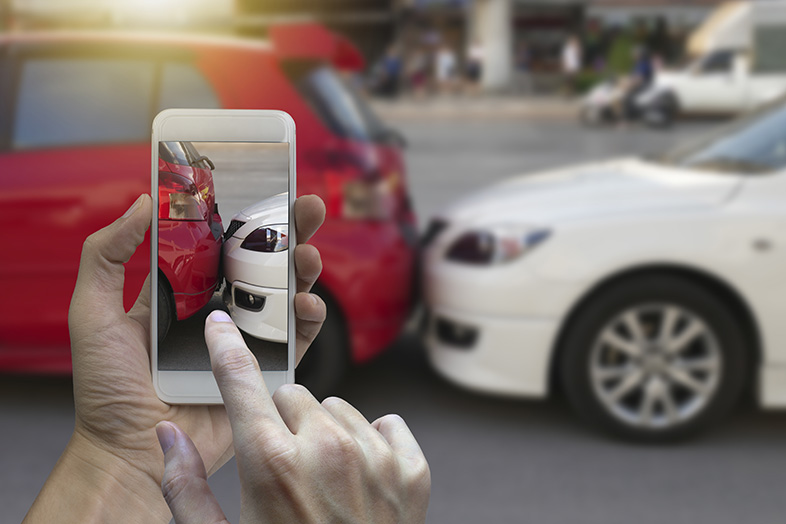According to the U.S. General Services Administration (GSA) Office of Motor Vehicle Management, there are around 6,420,000 car accidents on U.S. roads each year, with a car crash occurring somewhere in the nation every five seconds.
About 98 percent of these crashes result from human errors. If another driver's negligence injured you, you can seek compensation for the expenses and impacts of the injury through the personal injury claims process. Contact a car accident attorney for a free consultation today.
Types of Human Errors That Lead to Car Accidents
Human error can refer to any dangerous driving behavior resulting in a car accident. It also relates to mistakes committed by non-motorists that result in a car accident, such as defective parts resulting from a faulty engineered design or the failure of a governmental agency to properly maintain the roadway so that it is safe for drivers.
Here is a look at some of the most common types of human errors that lead to car accidents.
Speeding
The National Highway Traffic Safety Administration (NHTSA) notes that speeding is a factor in more than a quarter of all fatal accidents in the U.S., resulting in nearly 10,000 deaths and many thousands more injuries each year.
Speeding results in several hazards, including:

- Less time to react. A speeding driver has not only less time to recognize a hazard on the roadway but also less time to react to the hazard by pressing on the brakes.
- A longer stopping distance. No car stops instantly. Instead, braking is a process that involves a vehicle continuing to travel a distance while the brakes pull its weight of it to a stop. Heavier vehicles require more distance to come to a complete stop, as do those with bald tires or the driver attempting to stop on wet or icy roads.
- Confusion for other drivers. Drivers attempting to enter a travel lane from another lane or roadway while passing or turning can only do so if there is a safe gap in traffic. If the driver travels faster than expected, other drivers won't know if they have enough time to enter the lane.
- Less effective protective features. A car has several features to keep the driver safe during a crash, including the seat belt, airbags, and steel frame. Unfortunately, when a speeding vehicle is involved in a collision, the energy of the crash can increase beyond the protection offered by these features.
- Increased crash severity. When a vehicle increases its speed from 40 miles per hour to 60 miles per hour, the energy of a collision involving that vehicle more than doubles. This leads to harder impacts and an increased likelihood of serious injuries or even death.
Alcohol Impairment
Impairment by alcohol and other intoxicating substances is another major factor in car accidents. Alcohol factors in around 28 percent of all fatal accidents and impairment by other drugs in about 16 percent of all traffic fatalities.
Alcohol and other drugs can cause deficits in the skills needed for safe driving, such as:
- The ability to track moving targets, such as pedestrians crossing the roadway, or vehicles turning onto the street
- The ability to multitask, such as attending to the speed of the vehicle while ensuring that the traffic light is green and the driver has the right-of-way
- The ability to control lane position (swerving) and speed
- Short-term memory loss, including the inability to remember the last few miles traveled.
- Reduced information capacity, including the ability to tell when a traffic signal has changed
Distracted Driving
Distracted driving has become a greater concern for traffic experts in recent years due to the rise in popularity of the smartphone, which provides individuals with the opportunity to text, browse the internet, and respond to emails from their phones.
Consider that when it takes a driver to read or reply to a text while traveling at highway speeds, they will travel the distance of a football field without attending to the roadway. Texting and driving have become such a problem on U.S. roadways that many states have created hands-free driving laws that make it illegal for a driver to read or send emails or texts while driving or even sitting at a stoplight.
While texting is a serious concern, there are other types of driving distractions that can lead to accidents as well, including:
- Manual distractions such as eating, drinking, or smoking
- Visual distractions such as attending to pets or children in the backseat or looking at external features such as other people or cars, billboards, or even roadside accident scenes
- Cognitive distractions, such as visiting with a passenger, listening to music, or daydreaming
Failure to Yield
Roadway users of all types are required to yield the right-of-way to the traffic in other travel lanes when at a red light, crosswalk, stop sign, or changing lanes. Failing to yield the right-of-way can result in several crash types, especially those occurring in intersections, including the particularly dangerous broadside collision that occurs when the front of one vehicle collides with the side of another.
Left-turning drivers at intersections that only feature a solid green light, as opposed to a green arrow, are required to yield to traffic traveling straight through the intersection before they complete their turn.
Surprisingly, one of the most common reasons why a driver says they did not yield was that they didn’t see another vehicle, bicycle, or pedestrian approaching in the oncoming travel lane because they looked but didn’t see the approaching roadway user. As it turns out, this is sometimes true.
Inattentional blindness refers to how the brain processes a chaotic situation such as a busy intersection by seeing and responding to the biggest dangers the brain can detect, such as a semi-truck traveling in an adjacent lane, while missing other features of the scene, such as a smaller vehicle or motorcycle. While inattentional blindness is a natural condition of the brain, it's not a valid excuse when an accident occurs, as drivers must yield the right-of-way and ensure that a travel lane is clear before entering it.
Tailgating
Around one-third of the accidents on U.S. roadways are rear-end collisions, which occur when the front of one vehicle collides with the rear of another. While rear-end accidents are commonly called fender benders or minor crashes, hundreds of thousands of people are injured, and around 1,700 are killed yearly due to rear-end accidents. One of the most common causes of rear-end accidents is one vehicle following another vehicle too closely.
The problem with tailgating is that when a driver is following another vehicle too closely, they do not have a cushion of space in the event the vehicle in front of them suddenly stops or slows. This cushion—which is around three seconds—allows the driver to see that the driver in front of them stopped and respond by braking. The three seconds also allow for the distance it takes for the vehicle's brakes to pull its weight to a complete stop.
Aggressive Driving
According to a study conducted by the AAA Foundation for Traffic Safety, nearly 80 percent of drivers had experienced significant anger or aggression behind the wheel in the 30 days preceding the study. Aggressive driving refers to several hazardous driving practices that the driver undertakes in response to—or to get through—traffic congestion.
Some examples of aggressive driving practices include:
- Speeding in heavy traffic
- Improper lane changes, or threading traffic by slipping in and out of travel lanes without signaling to quickly pass other drivers
- Tailgating to get another vehicle to move out of the way or to prevent another vehicle from merging into the travel lane in front of the driver
- Brake checking another vehicle, which involves slamming on the brakes to force a tailgating driver to either rear-rend the vehicle or back off and quit following so closely
- Blocking cars to prevent them from changing lanes or turning
- Speeding up when another vehicle attempts to pass
Fatigue
Fatigued driving results from extreme physical or mental exertion that impairs the driver's performance. While anyone can experience driver fatigue from life changes, such as a new baby, or long hours at work, those most at risk of fatigued driving include long-haul truck drivers and individuals working the night shift, when the body instinctively wants to sleep.
Fatigue results in several deficits needed for driving safely, with many of these deficits mimicking alcohol impairment, such as the inability to maintain a consistent speed or lane position, short-term memory loss, and difficulty making good driving decisions. While lack of sleep is the most common cause of driver fatigue, certain physical conditions such as sleep apnea can also result in a driver not feeling well-rested, even if they have had a full night’s sleep.
Poorly Maintained Vehicles
Not all driver negligence pertains to how the driver is driving on the roadway. Failure to properly maintain a vehicle can also result in accidents.
Some types of dangerous vehicle defects that result from lack of maintenance include:
- Improper tire pressure, which can blow out tires. Having a blown-out tire generally causes a vehicle to become incredibly hard to maneuver.
- Bald tires can also result in a blowout, making it more difficult to stop the vehicle quickly if there is a hazard in the roadway.
- Engine failure results from not ensuring that the vehicle has the proper amount of oil and was changed regularly. If a driver fails to change their oil, the oil becomes thick and can no longer keep the engine from overheating.
- Leaking or low brake or steering fluid can result in soft, spongy brakes or a vehicle that is hard to steer.
- Burnt-out headlights or taillights. Other drivers rely on your lights to see you in dark situations and determine your intentions.
Product Defects
Manufacturers of the parts used on motor vehicles have the legal responsibility to ensure that those parts are reasonably safe, according to the part’s packaging label or the vehicle’s instruction manual. Unfortunately, errors in the engineering of the part, the manufacturing of it, or contained on the product’s label can result in accidents.
More than 800 vehicle recalls affect thousands of drivers in the U.S. each year.
Some common types of product defects that result in car accidents include:
- Defective airbags, including those that deploy at the wrong time, fail to deploy or deploy with too much force.
- Faulty ignition switches can cause the vehicle to lose power. Without power, the vehicle’s steering and brakes will not work effectively, and the airbags could fail to deploy.
- Defective fuel systems can lead to vehicles stalling in traffic.
- Manufacturing flaws in the tires can result in flats, blowouts, and even rollovers.
- Design flaws that make the vehicle less crashworthy, such as a high center of gravity in certain SUVs that can increase the likelihood of a rollover.
- Faulty brakes or brake lines could render the driver unable to control the vehicle.
How a Car Accident Attorney Can Help You With Your Claim

If another driver's negligence injured you, you can seek compensation for the expenses and impacts of the injury through the personal injury claims process. Contact An experienced car accident lawyer who can provide several services to assist you with your claim, including helping you value your case, determine liability, negotiate a settlement, file a lawsuit, and collect your compensation at the resolution of your case.
